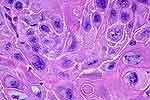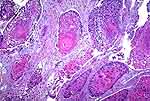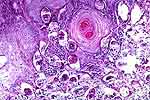 |
Figure 1: This is an invasive squamous cell
carcinoma. Compared to urothelial carcinoma, the cells have an abundance
of eosinophilic cytoplasm and clearly outlined cell borders. This
photomicrograph was selected to illustrate, for the non-pathologists, the
morphology of well differentiated squamous cells with unusually prominent
intercellular bridges. |
 |
Figure 2: This is a well-differentiated squamous
cell carcinoma. In the center, there is a large keratin pearl (arrow).
|
 |
Figure 3: This is also a well differentiated
squamous cell carcinoma with keratin pearls, and this example is
associated with schistosomiasis. |
 |
Figure 4: Moderately differentiated squamous cell
carcinoma. This field could be confused with a transitional cell
carcinoma, but there is some keratin (arrow) in the center and the cell
membranes are quite discrete. |
 |
Figure 5: Squamous cell carcinoma, pT2. Small,
brightly eosinophilic keratin deposits are present (arrows), especially on
the right but much of it is nonkeratinizing. This one would be diagnosed
as moderately to well-differentiated squamous cell carcinoma.
|

